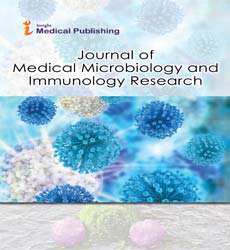ISSN : 2634-7164
Journal of Medical Microbiology and Immunology Research
The Role of Negative Pressure Wound Therapy (NPWT) as an Immunomodulator in Necrotizing Fasciitis
Omer Faruk Ozkan1*, Sema Yuksekdag1 and Ceren Canbey Goret2
1Department of General Surgery, Umraniye Research and Education Hospital, Istanbul, Turkey
2Department of Surgical Pathology, Sancaktepe Research and Education Hospital, Istanbul, Turkey
- *Corresponding Author:
- Omer Faruk Ozkan
Department of General Surgery
Umraniye Research and Education Hospital
Istanbul, Turkey
Tel: +902166321818
E-mail: ozkanfomer@gmail.com
Received Date: Oct 30, 2017; Accepted Date: Oct 30, 2017; Published Date: Nov 08, 2017
Citation: Ozkan OF, Yuksekdag S, Goret CC (2017) The Role of Negative Pressure Wound Therapy (NPWT) as an Immunomodulator in Necrotizing Fasciitis. J Med Microbiol Immunol Res 1:e104.
Copyright: © 2017 Ozkan OF, et al. This is an open-access article distributed under the terms of the Creative Commons Attribution License, which permits unrestricted use, distribution, and reproduction in any medium, provided the original author and source are credited.
Editorial
Necrotizing fasciitis (NF) is a severe infectious disease which is generally fulminant progressive with a high morbidity and mortality rate. NF is a synergetic infectious disease and usually reason is polymicrobial (both aerobic and anaerobic organisms) and affects the small vessels with thrombosis. All age groups can be affected with a male dominance. The predisposing factors have been well described and including history of trauma, crush injuries, cancer, and autoimmune diseases. Immediate debridement of all necrotic tissues, usage of broad-spectrum antibiotics and management of underlying diseases are the main cornerstones for management of disease [1-3].
After microbial invasion of tissue in such conditions, pathogens release exotoxins and endotoxins and this led to an increase the secretion of cytokines in the soft tissue and the infection consequently spreads to deep fascial tissues. The roles of inflammatory cells, cytokines, chemokines and gene regulation have been extensively studied. As a result, poor microcirculation, ischemia, cell death, and necrosis occur. Bacterias simultaneously cause coagulation by inducing platelet aggregation and activation of complement system. Anaerobic microorganisms cause formation of thrombosis by producing enzymes, especially collagenase and heparinase and this situation leads to bacterial overgrowth in deep fascia, infiltration of polymorphonuclear leucocytes, thrombosis in the veins and finally necrosis occur [3-5].
The medical management of Fournier’s gangrene shows similarity to the treatment of severe sepsis. Stabilization of the hemodynamics is the first step. Following debridement, the wound management is also essential for NF. A conventional wet-to-dry dressing is one of the well-known and accepted methods. This has few disadvantages such as frequent requirement of change, as a second, a relatively new choice, described as Negative Pressure Wound Therapy (NPWT) has been used in the wound management of NF. Once the necrosis is ended, NPWT helps wound healing physiologically. The negative pressure leads to an increased blood supply, increasing tissue perfusion, reducing edema, absorbs fluids and exudes, inhibit infection and as a last dry the wound and thus migration of inflammatory cells into the wound region. By this way, it promotes and accelerates the formation of granulation tissue by the removal of bacterial contamination and exudates [1-4].
A study demonstrated the positive effects of NPWT on serum fibronectin levels, which is an adhesion molecule, promoting the migration of inflammatory cells and remodeling phases. NPWT accelerates wound healing by promoting angiogenesis with the over-expression of angiogenin-1, Tie-2, α-SMA and collagen type IV [5]. In recent years a new pathway described that NPWT devices also promotes muscle-derived stem cell osteogenic differentiation through MAPK pathway immunologically [6].
In conclusion, NF is a quickly developing, life-threatening infection that affects the soft tissue and fascia. The roles of inflammatory cells, cytokines, chemokines, and gene regulation have been extensively studied. In future new pathways will described to explain the positive effect on microcirculation by angiogenesis, and formation of goodquality granulation tissue.
References
- Ozkan OF, Koksal N, Altinli E, Uzum MA, Cikman O, et al. (2016) Fournier's gangrene current approaches. Int Wound J 13(5):713-716.
- Ozkan OF, Altinli E, Koksal N, Senger S, Celik A (2015) Combining Flexi-Seal and negative presure wound therapy for wound management in Fournier’s gangrene. Int Wound J 12(3): 364-365.
- Park SJ, Kim DH, Choi CI, Yun SP, Kim JH, et al. (2016) Necrotizing soft tissue infection: analysis of the factors related to mortality in 30 cases of a single institution for 5 years. Annals of Surgical Treatment and Research 91(1):45-50.
- Sinha N, Niazi M, Lvovsky D (2014) A fatal case of multidrug resistant Acinetobacter necrotizing fasciitis: the changing scary face of nosocomial infection. Case Reports in Infectious Diseases 2014:705279.
- Koch C, Hecker A, Grau V, Padberg W, Wolff M, et al. (2015) Intravenous immunoglobulin in necrotizing fasciitis - A case report and review of recent literature. Ann Med Surg 4(3):260-263.
- Liu H, Zheng X, Chen L, Jian C, Hu X, et al. (2017) Negative pressure wound therapy promotes muscle-derived stem cell osteogenic differentiation through MAPK pathway. J Cell Mol Med.
Open Access Journals
- Aquaculture & Veterinary Science
- Chemistry & Chemical Sciences
- Clinical Sciences
- Engineering
- General Science
- Genetics & Molecular Biology
- Health Care & Nursing
- Immunology & Microbiology
- Materials Science
- Mathematics & Physics
- Medical Sciences
- Neurology & Psychiatry
- Oncology & Cancer Science
- Pharmaceutical Sciences
